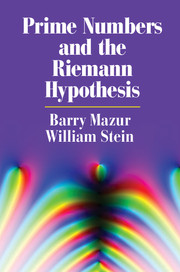Book contents
- Frontmatter
- Contents
- Preface
- PART I The Riemann Hypothesis
- 1 Thoughts About Numbers
- 2 What are Prime Numbers?
- 3 “Named” Prime Numbers
- 4 Sleves
- 5 Questions About Primes
- 6 Further Questions About Primes
- 7 How Many Primes are There?
- 8 Prime Numbers Viewed from a Distance
- 9 Pure and Applied Mathematics
- 10 A Probabilistic First Guess
- 11 What is a “Good Approximation”?
- 12 Square Root Error and Random Walks
- 13 What is Riemann's Hypothesis?
- 14 The Mystery Moves to the Error Term
- 15 Cesàro Smoothing
- 16 A View of|Li(X)-π(X)|
- 17 The Prime Number Theorem
- 18 The Staircase of Primes
- 19 Tinkering with the Staircase of Primes
- 20 Computer Music Files and Prime Numbers
- 21 The Word “Spectrum”
- 22 Spectra and Trigonometric Sums
- 23 The Spectrum and the Staircase of Primes
- 24 To Our Readers of Part I
- PART II Distributions
- PART III The Riemann Spectrum of the Prime Numbers
- PART IV Back to Riemann
- Endnotes
- Index
14 - The Mystery Moves to the Error Term
from PART I - The Riemann Hypothesis
Published online by Cambridge University Press: 05 May 2016
- Frontmatter
- Contents
- Preface
- PART I The Riemann Hypothesis
- 1 Thoughts About Numbers
- 2 What are Prime Numbers?
- 3 “Named” Prime Numbers
- 4 Sleves
- 5 Questions About Primes
- 6 Further Questions About Primes
- 7 How Many Primes are There?
- 8 Prime Numbers Viewed from a Distance
- 9 Pure and Applied Mathematics
- 10 A Probabilistic First Guess
- 11 What is a “Good Approximation”?
- 12 Square Root Error and Random Walks
- 13 What is Riemann's Hypothesis?
- 14 The Mystery Moves to the Error Term
- 15 Cesàro Smoothing
- 16 A View of|Li(X)-π(X)|
- 17 The Prime Number Theorem
- 18 The Staircase of Primes
- 19 Tinkering with the Staircase of Primes
- 20 Computer Music Files and Prime Numbers
- 21 The Word “Spectrum”
- 22 Spectra and Trigonometric Sums
- 23 The Spectrum and the Staircase of Primes
- 24 To Our Readers of Part I
- PART II Distributions
- PART III The Riemann Spectrum of the Prime Numbers
- PART IV Back to Riemann
- Endnotes
- Index
Summary
Let's think of what happens when you have a mysterious quantity (say, a function of a real number X) you wish to understand. Suppose you manage to approximate that quantity by an easy to understand expression – which we'll call the “dominant term” – that is also simple to compute, but only approximates your mysterious quantity. The approximation is not exact; it has a possible error, which happily is significantly smaller than the size of the dominant term. “Dominant” here just means exactly that: it is of size significantly larger than the error of approximation.
Mysterious quantity(X) = Simple, but dominant quantity(X) + Error(X).
If all you are after is a general estimate of size your job is done.You mightdeclare victory and ignore Error(X) as being – in size – negligible. But if you are interested in the deep structure of your mysterious quantity perhaps all you have done is to manage to transport most questions about it to Error(X). In conclusion, Error(X) is now your new mysterious quantity.
Returning to the issue of π(X) (our mysterious quantity) and Li(X) (our dominant term) the first formulation of the Riemann Hypothesis (as in Chapter 13 above) puts the spotlight on the Error term|Li(X) − π(X)|, which therefore deserves our scrutiny, since – after all – we're not interested in merely counting the primes: we want to understand asmuch as we can of their structure.
To get a feel for this error term, we shall smooth it out a bit, and look at a few of its graphs.
- Type
- Chapter
- Information
- Publisher: Cambridge University PressPrint publication year: 2016

